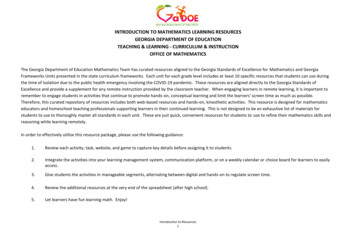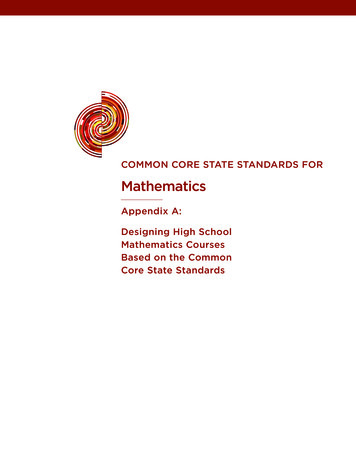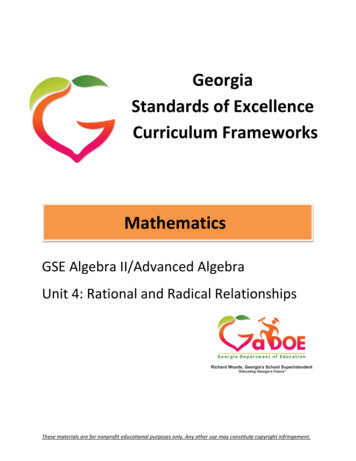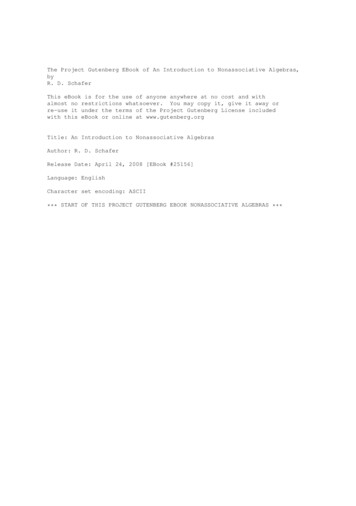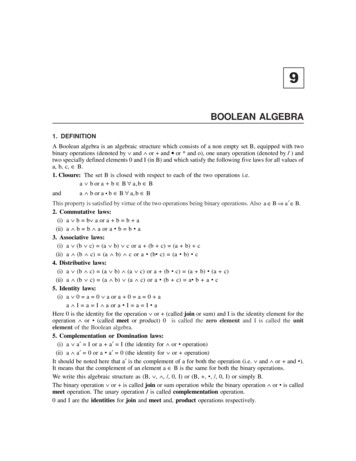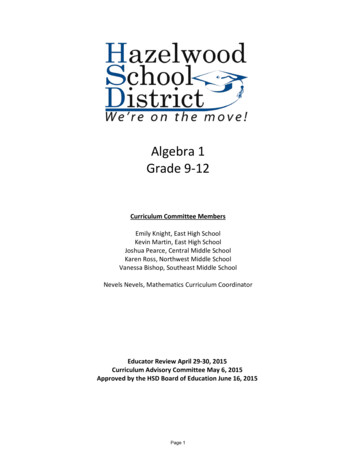
Transcription
Algebra 1Grade 9-12Curriculum Committee MembersEmily Knight, East High SchoolKevin Martin, East High SchoolJoshua Pearce, Central Middle SchoolKaren Ross, Northwest Middle SchoolVanessa Bishop, Southeast Middle SchoolNevels Nevels, Mathematics Curriculum CoordinatorEducator Review April 29-30, 2015Curriculum Advisory Committee May 6, 2015Approved by the HSD Board of Education June 16, 2015Page 1
TABLE OF CONTENTSAlgebra 1Hazelwood School District Mission Statement .3Hazelwood School District Vision Statement .3Hazelwood School District Goals . .3Course Overview 4Vocabulary .6Algebra 1 Unit 1 . 8Algebra 1 Unit 2 142Algebra 1 Unit 3 . .310Algebra 1 Unit 4 . .408Algebra 1 Unit 5 .515Page 2
Hazelwood School DistrictMission StatementWe are a collaborative learning community guided by a relentless focus to ensureeach student achieves maximum growth.Vision StatementHSD will foster lifelong learners, productive citizens and responsible leaders for anever-evolving society.Board of Education on January 5, 2010GoalsGoal #1: Hazelwood students will meet or exceed state standards in all curricularareas with emphasis in reading, writing, mathematics, science and social studies.Goal #2: Hazelwood staff will acquire and apply skills necessary for improvingstudent achievement.Goal #3: Hazelwood School District, the community and all families will supportthe learning of all childrenPage 3
COURSE TITLE: Algebra IGRADE LEVEL: 9 – 12CONTENT AREA: MathematicsCourse Description:The fundamental purpose of this course is to formalize and extend the mathematics thatstudents learned in the middle grades. Because it is built on the middle grades standards, thisis a more ambitious version of Algebra I than has generally been offered. The critical areas,called units, deepen and extend understanding of linear and exponential relationships bycontrasting them with each other and by applying linear models to data that exhibit a lineartrend, and students engage in methods for analyzing, solving, and using quadratic functions.The Mathematical Practice Standards apply throughout each course and, together with thecontent standards, prescribe that students experience mathematics as a coherent, useful,and logical subject that makes use of their ability to make sense of problem situations.Course Rationale:Algebra I is designed to provide students with a strong foundation in mathematics in order toprepare students for upper level mathematics courses. Students will also develop problemsolving skills by engaging in algebraic concepts.Unit 1: RelationshipsBetween Quantities andReasoning with Equations(22 days @ 90 min)Unit 4: Expressions andEquations(15 Days @ 90 min)Course Scope and SequenceUnit 2: Linear andExponential Relationships(19 days @ 90 min)Unit 3: Descriptive Statistics(12 Days @ 90 min)Unit 5: Quadratic Functionsand Modeling(17 days @ 90 min)Approved Course Materials and Resources:Glencoe Algebra 1 Textbook & Ancillaries, ALEKs Software, Missouri Learning Standards forMath, MAP Math Shell, Illustrative Mathematics Website, Achieve the Core Website,LearnZillion Website;Page 4
Unit ObjectivesUnit 1: Relationships Between Quantities and Reasoning with Equations Reason quantitatively and use units to solve problems. Interpret the structure of expressions. Create equations that describe numbers or relationships. Understand solving equations as a process of reasoning and explain the reasoning. Solve equations and inequalities in one variable.Unit 2: Linear and Exponential Relationships Extend the properties of exponents to rational exponents. Represent and solve equations, inequalities and systems graphically. Understand the concept of a function, function notation and interpret functions thatarise in applications in terms of a context. Analyze functions using different representations. Build a function that models a relationship between two quantities and from existingfunctions. Construct and compare linear, quadratic, and exponential models and solve problems. Interpret expressions for functions in terms of the situation they model.Unit 3: Descriptive Statistics Summarize, represent, and interpret data on a single count or measurement variable. Summarize, represent, and interpret data on two categorical and quantitativevariables. Interpret linear models.Unit 4: Expressions and Equations Interpret the structure of expressions. Write expressions in equivalent forms to solve problems. Perform arithmetic operations on polynomials. Create equations that describe numbers or relationships. Solve equations and inequalities in one variable. Solve systems of equations.Unit 5: Quadratic Functions and Modeling Use properties of rational and irrational numbers. Interpret functions that arise in applications in terms of a context. Analyze functions using different representations. Build a function that models a relationship between two quantities. Build new functions from existing functions. Construct and compare linear, quadratic, and exponential models and solve problems.Page 5
QuantityRational exponentReal numberQuadraticPolynomialFundamental theorem of AlgebraAlgebraLinearExpressionEquationExponential functionGeometric seriesFunctionsDomainRangeFunction notationFibonacci sequenceRecursive processInterceptsIncreasing intervalsDecreasing intervalsPositive intervalsNegative intervalsSymmetriesEnd behaviorPeriodicityRate of changePage 6
Statistics and ProbabilityDot plotHistogramBox plotInterquartile rangeStandard deviationOutlierFrequency tableRelative frequencyResidualsCorrelationCausationSample surveyExperimentObservational studiesPage 7
High School Number andQuantityRational exponentReal numberQuadratic equationPolynomialFundamental theorem of AlgebraVectorInitial pointTerminal pointVelocityHigh SchoolAlgebraComplete the squareMaximumMinimumExponential functionGeometric seriesRemainder TheoremBinomial TheoremPascal’s TriangleHigh SchoolFunctionsDomainRangeFunction notationFibonacci sequenceRecursive processInterceptsIncreasing intervalsDecreasing intervalsPositive intervalsNegative intervalsSymmetriesEnd behaviorPeriodicityRate of changeStep function Absolutevalue functionAsymptotePage 8Exponential functionPeriodMidlineAmplitude Exponentialgrowth Exponentialdecay Constantfunction Arithmeticsequence Geometricsequence
High SchoolGeometryAngleCirclePerpendicular linesParallel linesLine segmentsPointLineArcRigid motionCongruentAngle-Side-AngleHigh SchoolStatistics and ProbabilityDot plotHistogramBox plotInterquartile rangeStandard deviationOutlierFrequency tableRelative frequencyResidualsCorrelationCausationSample surveyExperimentObservational studiesPage 9Simulation dentConditionalprobability 2-wayfrequency tableAddition RuleMultiplication RulePermutationsCombinationsTheoretical probability
Algebra 1 Grade 9-12 Curriculum Committee Members Emily Knight, East High School Kevin Martin, East High School Joshua Pearce, Central Middle School Karen Ross, Northwest Middle School Vanessa Bishop, Southeast Middle School Nevels Nevels, Mathematics Curriculum Coordinator

